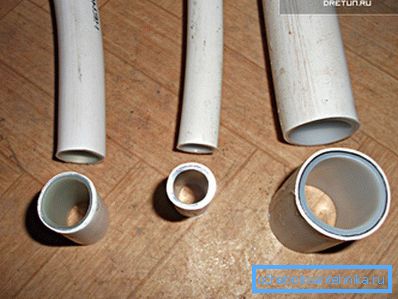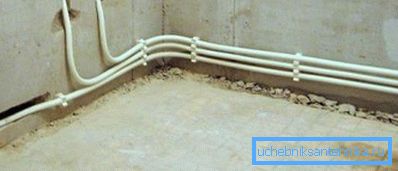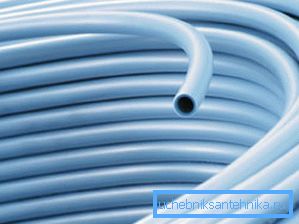Possible sizes of metal-plastic pipes and their features
Metal pipes are widely used in plumbing. With their help, water supply, heating and sewage pipelines are laid. It uses products with a variety of diameters, the range of which we will discuss in this article.

General provisions
For a start, let's take a look at the structure of the products in question and their characteristic features.
Structure

The structure of the product in question is simple:
- Internal polymer layer in contact with the liquid.
- Adhesive layer.
- Aluminum, giving the pipe the necessary rigidity and strength.
- Again the adhesive layer.
- External polymer layer that protects aluminum from contact with the external environment.
This structure guarantees several important advantages that make plastic pipes so popular when installing engineering systems of private houses and apartments.
Merits
Consider the characteristics of metal pipes:
- Resistance to corrosive processes. What is important for products that are constantly in contact with water.
- High transmittance due to the smoothness of the internal coating.
Tip: in the case of connecting plastic sections to metal, it is desirable to install special filters in the joint area. This will avoid rust and other debris from the old part of the pipeline to the new one.
- Acceptable strength properties, far superior to those that have conventional polypropylene or polyethylene models.
- Resistance to high temperatures, allowing the free use of plastic pipes in the heating system. For example, polyethylene models are categorically not suitable for such purposes due to the low temperature threshold.

- Affordable price. Even partial use of plastic in the production process can significantly reduce the cost of products.
- A light weight. Allows you to restrict simple attachments and does not exert additional load on the foundation of the building.
- Ecological purity. Complies with all necessary sanitary standards.
- Easy to use do-it-yourself. For the implementation of cutting metal-plastic pipes and the installation of their joints, it is not necessary to have any special skills.
Tip: for laying metal-plastic pipeline it is recommended to use a special tool - pressing key. With it, the process will be much easier and faster.

- Long service life, numbering decades, subject to compliance with all rules of operation.
Dimensions
The diameters of the products under consideration are quite diverse, as for water supply systems, samples with a size of 15 to 50 mm are most often used, but for sewage, from 32 to 150 mm. But the marking of plastic pipes is usually done in inches, so let's take a look at this unusual measure of length.
Tip: when choosing pipes it is recommended to take into account the internal diameter, which is denoted by two letters “DU” - “nominal diameter” The exterior can be very deceptive due to differences in the thickness of the walls.
Inches
To be precise, then 1 inch = 25.4 mm. In practice, the following relation is true in pipes:
| Inches | Millimeters |
| ? | 15 |
| ? | 20 |
| one | 25 |
| one? | 32 |
| one? | 40 |
| 2 | 50 |
| 3 | 80 |
| four | 100 |
| 6 | 150 |
Therefore, do not be surprised when a plumber or seller in a specialty store will describe the diameter as one second or three fourths. Just translate the size into the metric system, and it will be easier to navigate.
To connect sections of different size, a special calibrator is used.

Technical parameters for different diameters

The change in cross section affects the parameters of products in different ways:
| Parameter | Meanings | ||||
| Section, cm | 1.6 | 2 | 2.6 | 3.2 | four |
| Do, see | 1.2 | 1.6 | 2 | 2.6 | 3.3 |
| Forming layer width, cm | 0.2 | 0.2 | 0.3 | 0.3 | 0.35 |
| Mass cut length of 100 cm kg | 0.115 | 0.17 | 0.3 | 0.37 | 0.43 |
| The volume of one meter, l | 0.113 | 0.20 | 0.314 | 0.531 | 0.855 |
| Permissible heating at a pressure of 10 bar, aboutWITH | From 0 to 95 | ||||
| Permissible heating at a pressure of 25 bar, aboutWITH | From 0 to 25 | ||||
| Temperature limit aboutWITH | 135 | ||||
| Limit of withstand pressure at the time of maximum heating, bar | ten | ||||
| Destructive pressure during heating up to twenty degrees Celsius, bar | 94 | 87 | 88 | 76 | 67 |
| Smoothness index | 0.069 | ||||
| Heat insulation coefficient, W / m? K | 0.431 | ||||
| Strength indicator sizing, N / 10 mm | 71 | ||||
| Strength indicator of aluminum welding, N / mm2 | 58 | ||||
| No deformation when heated to 20 aboutC for sixty minutes, MPa | 5.7 | 5.09 | 5.42 | 5.11 | 4.83 |
| No deformation when heated to 95 aboutC for sixty minutes, MPa | 3.29 | 3.02 | 3.17 | 3.02 | 2.94 |
| No deformation when heated to 95 aboutC for one hundred hours, MPa | 2.92 | 2.68 | 2.82 | 2.69 | 2.61 |
| No deformation when heated to 95 aboutC for one thousand hours, MPa | 2.56 | 2.35 | 2.51 | 2.43 | 2.3 |
| Resistance to transverse rupture, N | 2870 | 3040 | 3250 | 3420 | 3560 |
| Durability with respect to compliance with all operational standards, years | Half a century | ||||
| Smallest bending radius with arms, cm | eight | ten | eleven | sixteen | 55 |
| The smallest bending radius with the use of special equipment, cm | 4.5 | 6 | 9.5 | 12.5 | 18 |

As you can see, many characteristics remain common to any size, and some radically change. For example, the service life, the bond strength of the layers and the coefficient of thermal conductivity are the same for thin samples as well as for thicker ones.
But the bending radius and resistance to deformations are already significantly different for different sections: the 16 mm metal-plastic pipe can withstand the greatest loads.

Conclusion
Pipes from aluminum and polymer combine many positive aspects of metal and plastic products, eliminating their disadvantages. Due to this, they are widely used in the arrangement of various pipelines, which, in turn, requires a variety of diameters.

The dimensions of the sections are measured in inches and usually vary from one second to six. This difference also has its effect on the technical characteristics of the products, which we have described in detail above. The video in this article will provide you with additional information directly related to the reviewed materials.